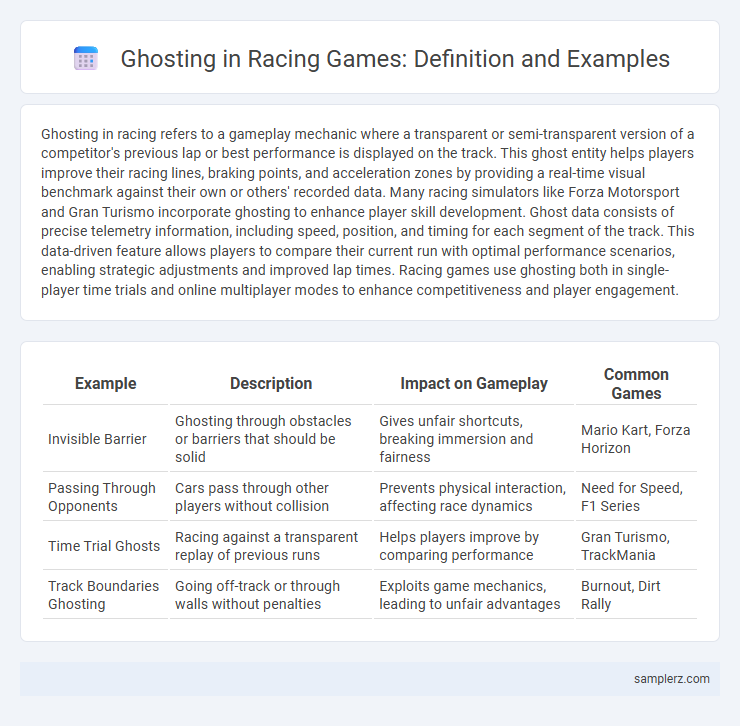Ghosting in racing refers to a gameplay mechanic where a transparent or semi-transparent version of a competitor's previous lap or best performance is displayed on the track. This ghost entity helps players improve their racing lines, braking points, and acceleration zones by providing a real-time visual benchmark against their own or others' recorded data. Many racing simulators like Forza Motorsport and Gran Turismo incorporate ghosting to enhance player skill development. Ghost data consists of precise telemetry information, including speed, position, and timing for each segment of the track. This data-driven feature allows players to compare their current run with optimal performance scenarios, enabling strategic adjustments and improved lap times. Racing games use ghosting both in single-player time trials and online multiplayer modes to enhance competitiveness and player engagement.
Table of Comparison
| Example | Description | Impact on Gameplay | Common Games |
|---|---|---|---|
| Invisible Barrier | Ghosting through obstacles or barriers that should be solid | Gives unfair shortcuts, breaking immersion and fairness | Mario Kart, Forza Horizon |
| Passing Through Opponents | Cars pass through other players without collision | Prevents physical interaction, affecting race dynamics | Need for Speed, F1 Series |
| Time Trial Ghosts | Racing against a transparent replay of previous runs | Helps players improve by comparing performance | Gran Turismo, TrackMania |
| Track Boundaries Ghosting | Going off-track or through walls without penalties | Exploits game mechanics, leading to unfair advantages | Burnout, Dirt Rally |
What is Ghosting in Racing Games?
Ghosting in racing games refers to a feature where players race against a transparent replay of their previous best performance, allowing them to compare lap times and improve driving skills. This semi-real-time visual serves as a benchmark, highlighting areas for acceleration, braking, and cornering optimization. Ghost data enhances competitive gameplay by fostering continuous improvement and precision in time trial challenges.
Classic Examples of Ghosting During Online Races
Ghosting in online racing occurs when a player temporarily becomes intangible, allowing them to pass through opponents and obstacles without collisions, significantly altering race dynamics. Classic examples include racing games like Mario Kart and TrackMania, where ghosting enables players to avoid crashes or bypass tight corners, creating a strategic edge in multiplayer matches. This mechanic often sparks debates about fairness, as ghosting can disrupt competitive balance by undermining the physical interactions essential to authentic racing experiences.
How Ghosting Improves Multiplayer Fairness
Ghosting in racing games allows players to pass through competitors without physical collision, reducing frustration caused by accidental crashes and enabling smoother gameplay. This mechanic promotes fair competition by ensuring that skill and strategy determine race outcomes rather than unintended physical interference. By minimizing disruptions, ghosting enhances the overall multiplayer experience and maintains balanced, competitive racing environments.
Real-World Racing vs. Gaming: The Difference Ghosting Makes
Ghosting in gaming racing enables cars to pass through each other without collision, allowing smoother gameplay and aggressive overtaking impossible in real-world racing. In real-world racing, collision consequences enforce strict spatial awareness and strategy, making ghosting an unrealistic advantage reserved for virtual environments. This fundamental difference highlights how ghosting transforms racing dynamics, emphasizing player skill in gaming while prioritizing physical precision on actual tracks.
Notable Games Featuring Ghosting Mechanics
Ghosting mechanics are prominently featured in racing games like the "Forza Motorsport" series, where players compete against "ghost" versions of their best lap times to improve performance. "Mario Kart" incorporates ghost racing by allowing players to race against transparent replays of their previous runs, enhancing competitive practice. The "TrackMania" franchise is also known for its extensive ghost mode, enabling players to race against their own or top players' recordings, fostering skill refinement and leaderboard competition.
Famous Ghosting Moments in Esports Racing
Ghosting in esports racing allows drivers to pass through opponents without collision, creating strategic moments that shape race outcomes. A famous example occurred during the 2020 F1 Esports Virtual Grand Prix, where Marcel Kiefer leveraged ghosting effectively to overtake rivals on the Monaco circuit, avoiding contact while gaining crucial positions. These ghosting moments highlight the skill and precision required to capitalize on digital physics in competitive virtual racing environments.
Technical Reasons for Ghosting in Racing Lobbies
Ghosting in racing lobbies often occurs due to network latency issues, where delayed data packets cause players to appear transparent or disconnected temporarily. Server synchronization problems between client and host can also result in ghosting, disrupting real-time position updates and collision detection. Insufficient bandwidth and high ping lead to inconsistent race state rendering, making ghosting a common technical challenge in online racing games.
Ghosting as a Tool Against Griefing and Trolls
Ghosting in racing games serves as a powerful tool to combat griefing and trolls by allowing players to temporarily become intangible, preventing collisions and aggressive interference from opponents. This mechanic creates a fair environment where racers can focus on skill and strategy without being disrupted by intentional hazards. By reducing frustration and promoting sportsmanship, ghosting enhances the overall player experience in competitive racing scenarios.
Player Reactions: Pros and Cons of Ghosting
Ghosting in racing games allows players to race against a transparent version of their best lap, offering a clear benchmark for performance improvement. Pros include precise skill tracking and motivation to beat personal records, enhancing competitive play and player engagement. Cons involve potential frustration from constant comparison and reduced unpredictability, which can diminish the excitement and challenge of live multiplayer races.
Future Innovations in Ghosting for Racing Titles
Future innovations in ghosting for racing titles include enhanced AI-driven ghost models that adapt dynamically to player skill levels, creating more realistic and challenging opponents. Integration of cloud-based race data allows seamless sharing and comparison of ghost runs across global leaderboards, fostering competitive community engagement. Advanced telemetry analysis leverages machine learning to optimize ghost behavior, providing personalized training tools that improve player performance over time.

example of ghosting in racing Infographic
 samplerz.com
samplerz.com